#software development in Europe
Explore tagged Tumblr posts
Text
Top Custom Software Development Companies in Europe [2025]
European companies are progressively adopting tailored software solutions to work more effectively. For organizations seeking a best-in-class custom software development partner, we present a selection of firms offering comprehensive, end-to-end services. It's vital to recognize the significant difference in the capability of various development providers to deliver genuinely effective custom software.
In order to facilitate the identification of your optimal partner, we have compiled a list of the most reputable custom software development companies in Europe, all of whom possess the capability to develop software solutions tailored to your specific business requisites.
VeryCreatives
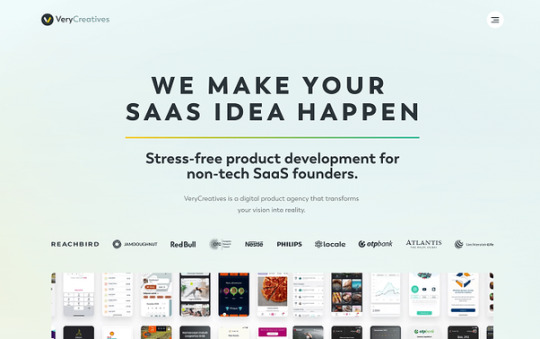
VeryCreatives, a recognized leader in design and development, empowers businesses worldwide with exceptional software solutions. Our seasoned professionals excel at attracting more potential users and converting them effectively, leading to robust customer bases, improved retention, and substantial revenue streams for our partners.
Aionys

Aionys, a reputable custom software development company founded in Bulgaria in 2016, offers expert digital product development services to the financial services industry. Their strength lies in their experienced team of software developers, designers, project managers, and QA engineers, who are dedicated to delivering tailored and high-quality solutions.
instinctools
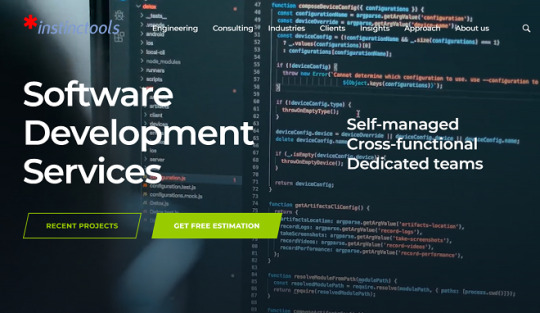
instinctools, with a history spanning over 10 years, specializes in the development of state-of-the-art software solutions designed to address unique business challenges. The company's distinctive methodological approach, coupled with the assembly of an exceptional cadre of technical talent at their Kraków headquarters in Central Europe, solidifies their position as a preeminent software firm in Poland.
Dotcode
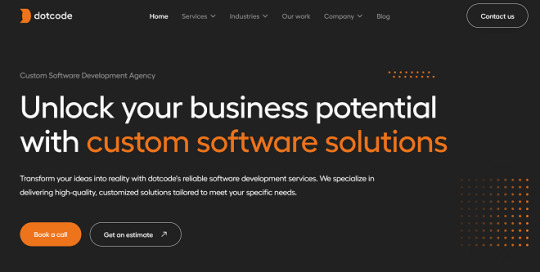
For businesses and startups in the EU market, Dotcode, a custom software development company based in Ukraine with offices in the UK and US, specializes in building dedicated development teams. Their platform showcases their successful project history, and they offer IT outsourcing services to enhance existing products and develop scalable tech solutions globally.
Sigma Software
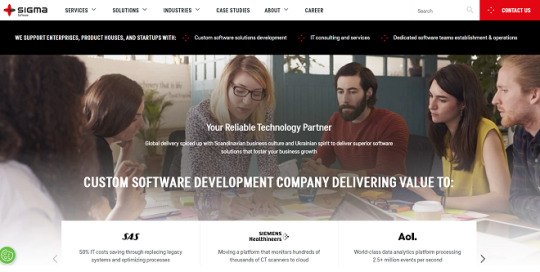
Sigma Software, founded in 2009, serves a wide international clientele, from the US to Australia, with a strong domestic and global presence. They specialize in tailored web and mobile application development and are recognized for their excellent client communication, high-quality code, and a reliable warranty period of 12 months or more.
DIGIWEDO

DIGIWEDO, a custom software development firm with a strong history, specializes in developing Minimum Viable Products (MVPs) and complete digital products for agile companies worldwide. They have expertise in Ruby on Rails for web applications and building feature-rich applications for both iOS and Android. DIGIWEDO has successfully delivered over 300 projects to clients in over 20 countries, managing the entire development lifecycle from the initial idea.
Strypes
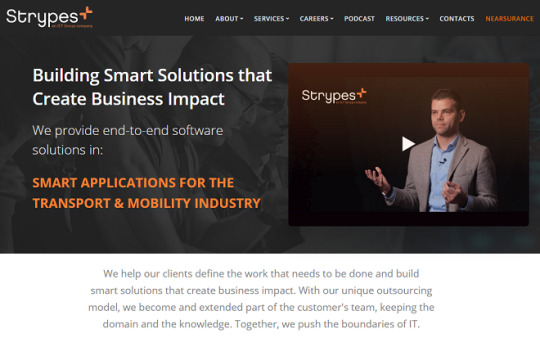
Strypes, a software house located in Eindhoven, Netherlands, provides both the establishment and management of dedicated development teams, configured to meet the bespoke requirements of its clientele, and the delivery of end-to-end projects across a range of core sectors, including IT infrastructure, Smart Applications, Remote Diagnostics and Monitoring software, Transport and Mobility, Cloud Solutions, and diverse business verticals.
CodeFirst

CodeFirst, a Custom Software Development Company, employs agile delivery methodologies and leverages its expertise in software development to ensure the provision of premium custom software solutions within the European market. The company is committed to delivering software products within or ahead of stipulated deadlines and at competitive pricing. Each project is regarded as an opportunity to apply the company's extensive experience, innovative solutions, and discerning intuition to consistently surpass client expectations.
#custom software development#software development#software developers#software development in Europe
0 notes
Text



I found myself surrounded by companions daring to tackle a real software architecture challenge. We shared a good wine and cheese to conquer it together! (Unfortunately, there’s always something waiting to be dealt with on Monday.)
The glow of my Neovim terminal in Monokai theme reflects my rhythm — a guy who doesn’t stop on weekends but knows that balance isn’t about being all-in, all day.
The setup screams character: a seamless fusion of productivity and comfort. Lazygit commands at my fingertips, a Ghibli-esque avatar paired with Neofetch adding a touch of Tumblr aesthetic, and a playlist of Korean indie OSTs playing in the background to add depth to every keystroke.
This is how I drive — in code, creativity, and moments that are unapologetically mine.
#study blog#study aesthetic#studyblr#programmer#software development#student#studyblr community#studyblr europe#studyblr aesthetic#dark academia#dark aesthetic#night sky#student life#student university#developer#coding#programming#software#softwareengineering#software engineer#software engineering#software developers#devops#studyblr brazil#studies#study inspiration#study spot#self improvement#aesthetic
60 notes
·
View notes
Text
Best Web and Software Solutions Personalized for Your Company

Today, it's crucial for any business to have a strong online presence in the digital age. IT Solution company offers web and software solutions to help your business stand out and succeed, whether you're a small business owner or part of a large company. It creates websites and software that are tailored to your specific needs.
Software Solutions team of skilled developers is dedicated to building solutions that work for you. It uses the latest technology to design websites that look great and function smoothly. Whether you need a new website, an e-commerce platform, or a custom software application, we can make it happen.
Software Solutions understands that every business is unique, so we take the time to learn about your goals and challenges to create software solutions that match your vision. Its websites and software are designed not just to look good, but to drive real results for your business.
Its focus is on creating easy-to-use and secure solutions. Your customers will have a great experience when they visit your website, and software will help you run your business more efficiently. Additionally, Software Solutions are designed to grow your business and continue to meet your needs as you expand.
It provides ongoing support to ensure everything runs smoothly. As your business grows, we'll be there to update and improve your digital tools so you can keep focusing on what you do best.
#software#website#ai#it#software solutions#uk#europe#web development#web design#mobile app development
3 notes
·
View notes
Text
Why Mobcoder AU Is the Software Development Company You Can Trust?
Are you trying to find a trustworthy Australian software development company? Mobcoder AU provides secure, scalable, and creative digital solutions that are customized to meet your company's objectives. We transform complex concepts into powerful web and mobile applications by utilizing expert teams, agile processes, and a user-focused methodology. Mobcoder AU blends technological prowess with lucid communication for outcomes that genuinely have an effect, regardless of your company's size.
#911 abc#andor#arcane#artists on tumblr#cats of tumblr#conclave#cookie run kingdom#eurovision#f1#jujutsu kaisen#software#machine learning#technology#information technology#digital transformation#cybersecurity#mobile app development#mobileappdesignbd#mobile application development#mobile app developers#mobileappscrapingservices#australia#asia#europe#perth#melbourne#africa
0 notes
Text

Experience GITEX Europe 2025: AI, Healthtech & Custom Software Development Solutions
Explore the future of Healthtech, AI, and custom software development at GITEX Europe 2025 in Berlin. Join 40,000+ tech leaders and discover cutting-edge innovations, including AR/VR, cybersecurity, cloud, and healthcare IT. Visit DreamSoft4u’s booth for next-gen software services and intelligent digital solutions.
#GITEX Europe 2025#custom software development#Healthtech#AI in healthcare#AI development services#healthcare IT solutions#DreamSoft4u#Messe Berlin tech expo#custom application development#software development company#XR technology#cybersecurity solutions#quantum computing#cloud computing#smart industries#tech expo Europe#digital transformation#software services#healthcare software development#generative AI#AR/VR in healthcare#sustainable tech#digital health solutions#custom healthcare software#AI-powered software#technology trends 2025
1 note
·
View note
Text
Odoo CRM Enterprise Edition Features 2025

Curious about what Odoo CRM Enterprise Edition offers in 2025? This in-depth blog post explores all the key features that make it a powerful tool for managing customer relationships—from advanced lead handling and intelligent sales pipelines to integrated activity scheduling, AI-assisted tools, and mobile access. Whether you're looking to optimise your workflow, enhance team collaboration, or better understand how Odoo fits into a modern business ecosystem, this post provides a clear and comprehensive breakdown of every major functionality. Ideal for business owners, sales professionals, and ERP consultants who want a full picture. Click here to read more
#erp#erp software#erp solution bd#erp system#erpsoftware#odoo development#odoo#odoo development company#odoo development services#odoo erp#crm services#seo services#digital marketing services#services#development#software development#wordpress development#web development#developer#europe#asia#africa#germany#france#bulgaria#new zealand#australia#italy#austria#belgium
0 notes
Text
The Future of Software Development: Trends, Challenges, and Opportunities
In the tech world, whatever commercial purpose software development needs to keep evolving in market and user experiences. Whether it’s web applications, mobile apps, or AI-driven solutions, the demand is always at its peak.
How to explore the software development company? Staying ahead of market trends is more effective in delivering high-quality solutions. Let’s see the matter.
Urging find-outs in Software Development
Technology is booming rapidly, and new markets are reshaping the IT software development company landscape. We list it out below:
Artificial Intelligence (AI) and Machine Learning (ML) AI and ML are transforming industries by smart automating processes, improving decision-making, and enhancing customer experiences. Businesses are investing in AI-powered applications to stay competitive.
Cloud Computing Cloud-based solutions allow companies to store and access data from anywhere. Platforms like AWS, Google Cloud, and Azure are helping businesses scale effectively.

Blockchain is ruling industries by confirming security, transparency, and decentralized solutions. It is broadly used in finance, healthcare, and logistics management.
The Internet of Things (IoT) connects devices and switches real-time data collection. Businesses use IoT for smart homes, healthcare monitoring, and industrial automation.
How it would challenge in Software Development
While software development is engaging, it comes with its own set of
Challenges:
Security Concerns Cybersecurity threats are increasing, making it essential for developers to create secure applications. Companies must invest in strong encryption and data protection measures.
Scalability Issues As businesses grow, their software should handle increasing data loads and user demands. Scalable architectures are critical for long-term success.
Cross-Platform Compatibility Developing software that works smoothly across different devices and operating systems requires advanced coding and testing strategies.
Changing Technology New frameworks and programming languages emerge frequently. Developers must keep evolving the latest innovative technologies.
Opportunities in Software Development
Despite challenges, there are several opportunities for a software development company to expand its reach and grow its business:
Custom Software Solutions: Many businesses need crafted software to meet their unique needs. Offering custom development services can help companies stand out.
Remote Works: With the rise of remote work, businesses require tools for collaboration, communication, and productivity. Developing such solutions can be profitable.
E-commerce and Mobile App Development: The demand for e-commerce platforms and mobile applications is highly increasing. Providing specialized solutions in this area can attract global clients.
AI-Powered Applications Businesses seek AI-driven solutions for automation, customer support, and data analysis. Investing in AI can open new revenue streams.
Wrapped up:
Software development continues to engage, bringing new trends, challenges, and opportunities. As a leading IT software development company, staying ahead of technology and adapting to changes is the key to success.
Whether you are looking for custom software solutions, mobile app development, or AI-powered applications, molding up-to-date trends will help businesses grow and stay competitive in the global market.
#futureAI#software development#AIapplications#globalmarket#business#custom mobile app development company#marketing#mobile app development#services#serviceapp#blockchaintechnology#softwaredevelopmentcompany#ITsoftwarecompany#usa#unitedstates#unitedkingdom#europe#uae#australia#poland#entrepreneur#startup
0 notes
Text
How Professional Designers Can Help
At Professional Designers, we specialize in creating bespoke web design services tailored to meet the needs of Swiss businesses. By focusing on both UX and UI, we ensure that our clients’ websites are not only visually appealing but also highly functional and user-friendly. Whether you need a website redesign or a complete overhaul of your website development services, our team of expert web designers in Schweiz can help boost customer engagement and retention.
#switzerland#suisse#neuchatel#france#germany#spain#austria#europe#london#website#web development#web design#software#technology#website design#ui ux design#ui ux company#ui ux agency#ui ux development services#business#ecommerce#marketing#services
1 note
·
View note
Text
Many firms prefer ready-made AI software with a few tweaks - Technology Org
New Post has been published on https://thedigitalinsider.com/many-firms-prefer-ready-made-ai-software-with-a-few-tweaks-technology-org/
Many firms prefer ready-made AI software with a few tweaks - Technology Org


Artificial intelligence has changed nearly every industry, from manufacturing and retail to construction and agriculture. And as AI becomes even more ubiquitous, firms often opt for off-the-shelf technology that can be modified to meet their needs.
Chris Forman, the Peter and Stephanie Nolan Professor in the Dyson School of Applied Economics and Management in the Cornell SC Johnson College of Business, was part of a research team that examined firms’ decisions to adopt AI technology and how that adoption was sourced: by purchasing ready-made software; by developing their own; or with a hybrid strategy, which the researchers say may reflect “complementarity” among sourcing approaches.
In an analysis of more than 3,000 European firms, they found that many—particularly in science, retail trade, finance, real estate, and manufacturing—are increasingly opting for ready-made technology tailored to the firm’s specific needs. While AI may seem to be threatening the human workforce, these findings indicate that workers with AI-related skills will still be needed.
“In the vast majority of industries, firms are doing both readymade and in-house development, and I think it’s an interesting question for future work to understand why that’s the case,” said Forman, co-author of “Make or Buy Your Artificial Intelligence? Complementarities in Technology Sourcing,” which published March 5 in the Journal of Economics and Management Strategy.
“Ready-made software is important,” he said, “but for the vast majority of firms, it does not appear to be a substitute for in-house software, which suggests that it’s not, at least in the short run, going to eliminate the need for AI-related skills.”
Charles Hoffreumon, a doctoral student at the Solvay Brussels School of Economics and Management, is the corresponding author. Nicolas van Zeebroeck, a professor of digital economics and strategy at the Solvay Brussels School, is the other co-author.
For their study, the researchers examined data from a survey conducted in 2020 by the Directorate-General of Communications Networks, Content and Technology from the European Commission (EC), which assessed AI adoption across the 27 countries of the European Union. The team used data from 3,143 firms across Europe in the study.
Business software is hard to implement, and historically as new technologies spread firms have relied on ready-made software. “This aspect of trying to understand the extent to which ready-made software could potentially substitute for the need for skills was interesting.” Forman said.
The study’s data comprised firms in 10 industry sectors, with the largest share coming from manufacturing (19%), trade and retail (18%), and construction (12%). Industries with the smallest share of respondents included agriculture (4%) and utilities (3%).
Firms most commonly use AI for the following purposes: fraud or risk detection, process or equipment optimization, and process automation in warehouses or robotics.
Among respondents who had adopted at least one AI application, more than 58% reported using ready-made software; nearly 38% hired an external consultant; 24% used modified commercial software; 20% used in-house software; and 20% modified open-source technology for their firm’s needs. Some firms deployed the technology in multiple ways.
Among the findings: The financial and scientific sectors – and to a lesser extent IT – preferred developing and customizing their own software while agriculture, construction and human health preferred ready-made solutions.
Forman said that in the past, as new technology spreads, the demand for different types of skills emerges. “Historically, the net effect has tended to be that, overall, labor demand goes up,” he said, “but it remains to be seen what happens in this case.”
As often happens with new technology, Forman said, the diffusion of AI technology to early adopters has resulted in users’ best practices getting incorporated into ready-made software, which makes these solutions even better. This was the case, he said, with enterprise resource planning – automation software that helps to run an entire business.
“When you look at prior digital technologies, there’s often a process of complementary innovation, or co-invention, where you figure out how to use this digital technology most effectively for your firm,” Forman said. “That usually takes place over time, through experimentation and figuring out what works and doesn’t.”
The authors wrote that this research “has taken the first steps toward highlighting the importance of sourcing strategies to understanding the diffusion of AI.”
Source: Cornell University
You can offer your link to a page which is relevant to the topic of this post.
#000#A.I. & Neural Networks news#agriculture#ai#Analysis#artificial#Artificial Intelligence#artificial intelligence (AI)#automation#Business#business software#college#commercial software#communications#construction#content#data#detection#development#diffusion#Digital technology#Economics#enterprise#enterprise resource planning#equipment#Europe#european union#finance#financial#fraud
0 notes
Text
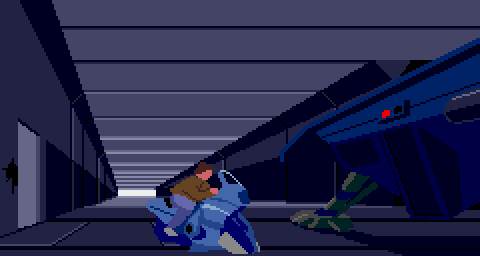
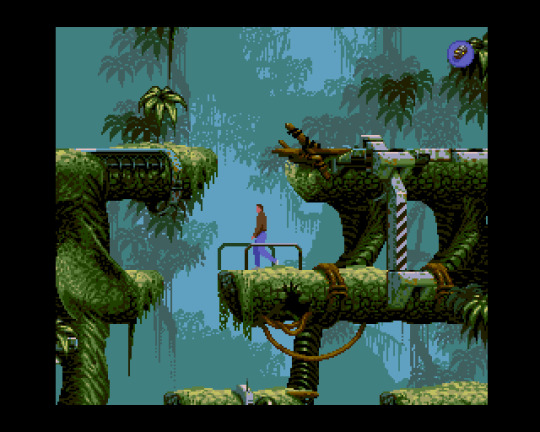
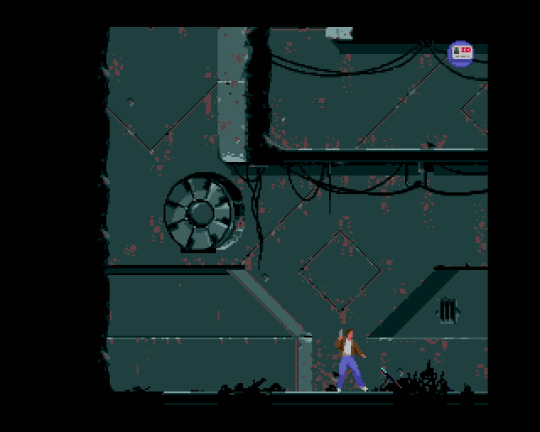

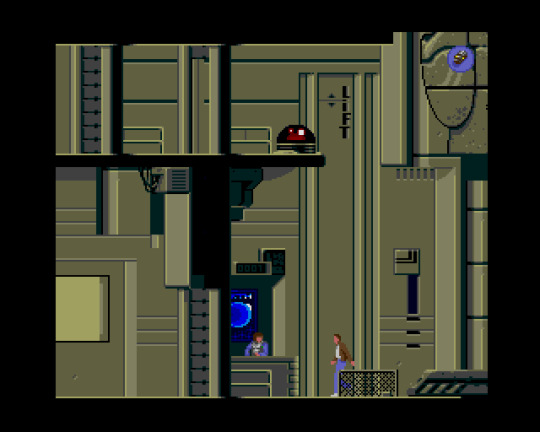
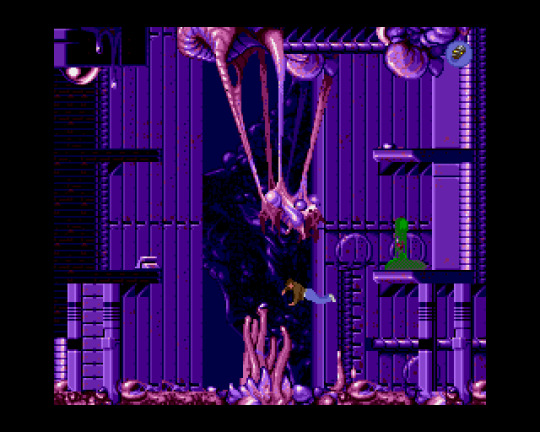
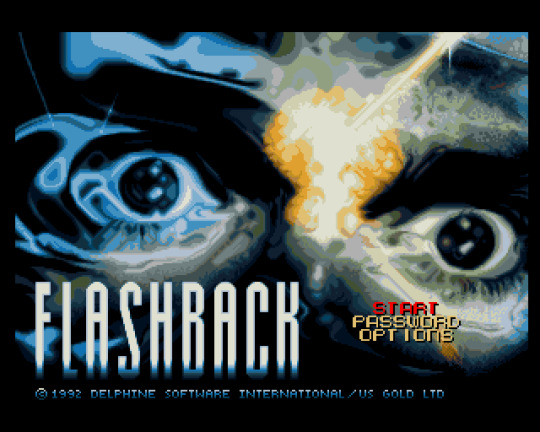
Flashback (1992)
Commodore Amiga
Flashback, released as Flashback: The Quest for Identity in the United States, is a 1992 science fiction cinematic platform game developed by Delphine Software of France. It was published by U.S. Gold in the United States and Europe and by Sunsoft in Japan.
A successor of sorts to the equally brilliant Another World, Flashback might look at first glance to be your typical 2D platformer. Still, it skillfully blends cinematic scenes with reflex-testing action to create one of the most memorable pixel graphics games of all time.
While it would find global fame on consoles (and director Paul Cuisset has been quoted as saying the Mega Drive version is the best), the Amiga version is where Flashback made its initial impact; this is effortlessly one of the finest games on Commodore Amiga.
https://en.wikipedia.org/wiki/Flashback_(1992_video_game)
#big pixel is beautiful#pixel graphics#pixels#pixel art#retrogaming#retro gaming#90s#commodore#commodore amiga#amiga#flashback#another world#2d platformer#u.s. gold
48 notes
·
View notes
Note
I still believe the craziest form of computer program storage format from the 1980s is the cassette tape. Logical I get it but to store entire programs on little tape (that I only remember using to play music) is just crazy to me. Idk
Agreed, cassette tape for data storage was really clever. The concept had its heyday was the 1970s in a wide variety of encoding schemes for different computer platforms. It did persist into the 80s, mostly in Europe, while the US switched to floppy disks as soon as they were available for systems. The majority of my Ohio Scientific software is on cassette.
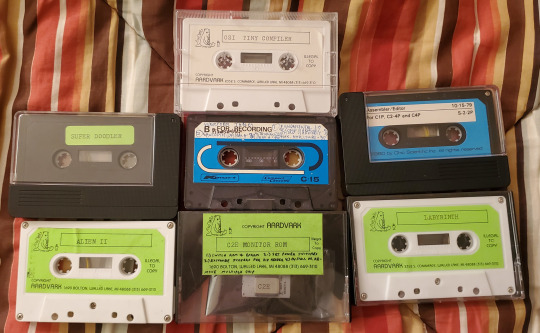
Talking with UK vs. US Commodore 64 users in particular will highlight the disparity in which storage mediums that were commonplace. I've got a few pieces of software on tape for mainly the VIC-20, but I rarely bother to use it, because it's slow and annoying. To be fair, Commodore's implementation of data storage on tape is pretty rock solid relative to the competition. It's considered more reliable than other company's but Chuck Peddle's implementation of the cassette routines are considered quite enigmatic to this day. He didn't document it super well, so CBM kept reusing his old code from the PET all the way through the end of the C128's development 7 years later because they didn't want to break any backward compatibility.

The big thing that really made alot of homebrewers and kit computer owners cozy up to the idea was the introduction of the Kansas City Standard from 1976. The idea of getting away from delicate and slow paper tape, and moving towards an inexpensive, portable, and more durable storage medium was quite enticing. Floppy disk drives and interfaces were expensive at the time, so something more accessible like off the shelf audio tapes made sense.
I've linked two places you can read about it from Byte Magazine's February 1976 issue below (check the attribution links).
You might recognize a familiar name present...
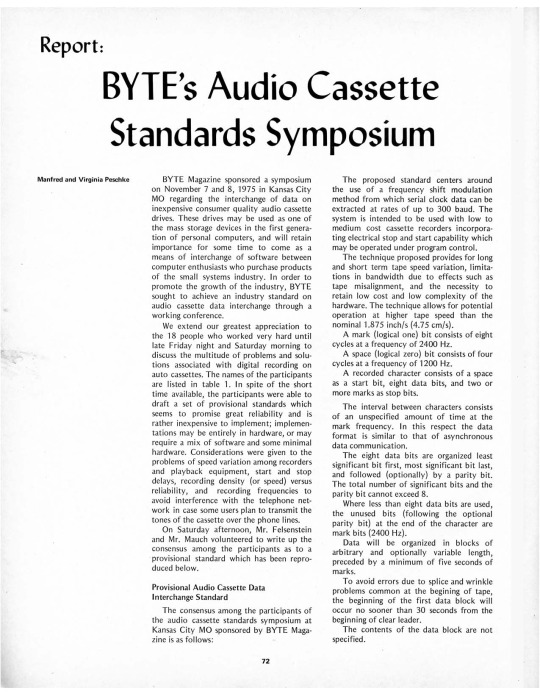
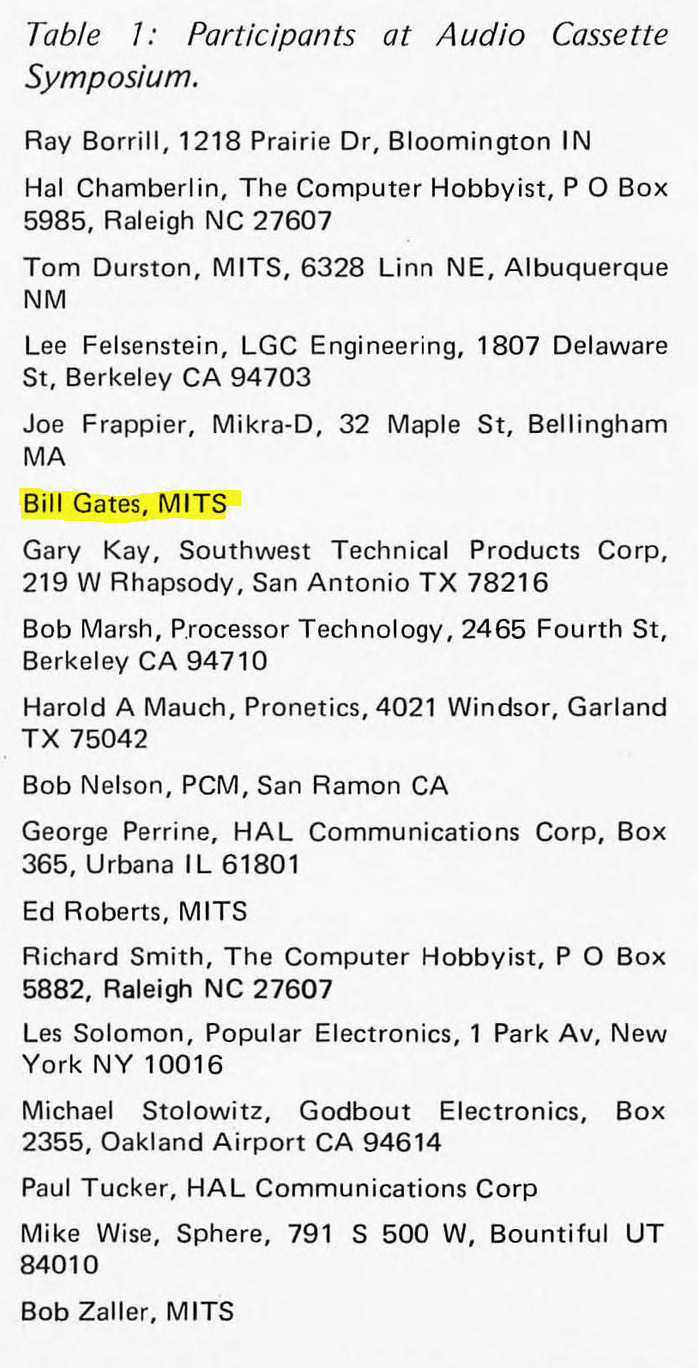
There are a few ways to encode binary data on tape designed to handle analog audio, but the KCS approach is to have 1's be 8 cycles of 2400Hz tone, and 0's be 4 cycles of 1200Hz tone. I say cycles, because while 300 baud is the initial specification, there is also a 1200 baud specification available, so the duration of marks vs spaces (another way of saying 1's and 0's), is variable based on that baud rate. Many S-100 computers implemented it, as do a few contemporary proprietary designs.
The big 3 microcomputers of 1977 that revolutionized the industry (Apple II, Commodore PET 2001, and Tandy TRS-80 Model I) each have their own cassette interface implementation. It kept costs down, and it was easy to implement, all things considered. The Apple II and TRS-80 use off-the-shelf cassette deck connections like many other machines, whereas the original variant of the PET had an integrated cassette. Commodore later used external cassette decks with a proprietary connector, whereas many other companies abandoned tape before too long. Hell, even the original IBM PC has a cassette port, not that anybody bothered to use that. Each one used a different encoding format to store their data, rather than KCS.
Here's a sample of what an OSI-formatted tape sounds like.
And here's a Commodore formatted tape, specifically one with VIC-20 programs on it.
I won't subject you to the whole program, or we'd be here all day. The initial single tone that starts the segment is called the "leader", I've truncated it for the sake of your ears, as well as recorded them kinda quietly. I don't have any other tape formats on hand to demonstrate, but I think you get the idea.
You can do alot better than storing programs on tape, but you can also do alot worse -- it beats having to type in a program every time from scratch.
273 notes
·
View notes
Text
Rayman Together Community Spotlight #4 - MarkedAsUnreal

Introduction:
Rayman 3: Hoodlum Havoc was published by Ubisoft Paris and released on February 21st, 2003, in Europe and in March 2003 worldwide. That was almost 22 years ago. Feeling old yet? Well, Ubisoft did release Rayman 3: HD in 2012, but we won't talk about that. Rayman 3 is undoubtedly a fan favorite in the series thanks to its whimsical but very risque adult humor. The game is also critically acclaimed thanks to its very fun and diverse 3D platforming and its exceptional cast of characters and enemies. Nothing has ever come close in the series to the success of Rayman 3, in my opinion. And while I wait in hope for Ubisoft to bring back Rayman to his core 3D roots, I can't help thinking, Why doesn't Ubisoft just remake Rayman 3.
Fortunately, this is no longer an issue. For this latest Rayman Together Community Spotlight, I have the pleasure of interviewing Marked As Unreal, a Rayman fan from Poland who is working on the Rayman 3 Fan Remake on YouTube. This ground-breaking development blog focuses upon reimaging Rayman 3: Hoodlum Havoc using Unreal Engine 5. The development process has been fascinating to watch, and this has become undoubtedly a favorite fan project of mine. The results have been spectacular, and the game looks simply incredible. You can see the results for yourself below from these comparison shots.
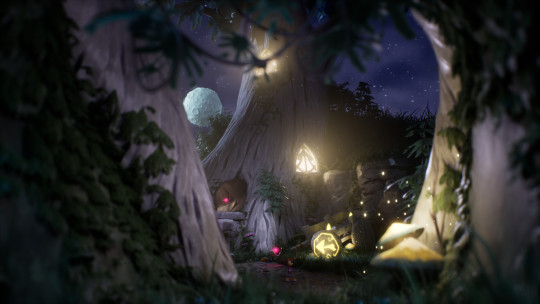
(Rayman 3: Unreal Engine Fan Remake)

(Rayman 3: Hoodlum Havoc)

(Rayman 3: Unreal Engine Fan Remake)

(Rayman 3: Hoodlum Havoc)
So sit back and relax as this latest community spotlight takes you into more detail about the genius behind the Rayman 3: Fan Remake and a more personal insight into this amazing community project.
Spotlight:

1. Please introduce yourself.
"Hi! I’m Mark. I’m a gaming enthusiast from Poland who dreams of making his own small indie title one day. To help me achieve that goal, I’m currently trying to learn game development and Unreal Engine by remaking one of my favorite games of all time, Rayman 3. I didn’t have much coding or Unreal Engine experience prior to this project, but I did work as a 3D artist for almost 4 years. The most notable project I’ve worked on as a 3D artist was “The Medium” by the Bloober team. What was really awesome about this project is that its art style is based on Zdzislaw Beksinski’s paintings, who is a painter that I am a big fan of."

2. What do you do for a living?
"For most of the year I work at a campground doing maintenance, but in the summer I work at an ice cream/waffle shop."

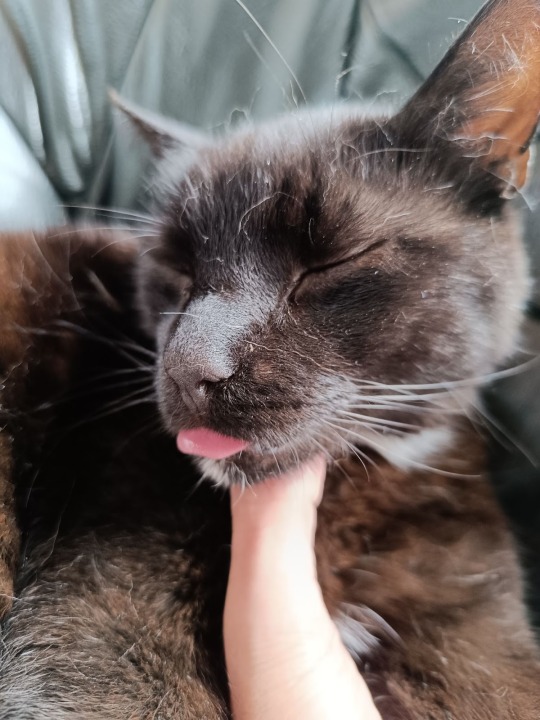
3. What do you enjoy doing in your spare time
"I often play games and watch various shows when I’m looking to have a chill time. There are many games which I would consider my favorites, but to name a few (besides Rayman of course), there are the old Halo games, the Dead Space series, Old School RuneScape, Subnautica, the Bioshock series, Portal 2, Undertale, from software games, or the Respawn Entertainments Jedi series. As shows are considered, I lately find myself really enjoying anime. My favorites are Vinland Saga, Attack on Titan, and Jojo’s bizarre adventure. Jujustsu Kaisen is also really sick. Regarding more active ways to spend my free time, I really love bouldering (it’s a type of rock climbing) and snowboarding."


4. What got you into the Unreal Engine project on Rayman 3?
"Learning game development by trying to recreate one of my favorite games just seemed like it could be a ton of fun (and I wasn’t wrong, because it is a blast!). And I decided to go for Unreal Engine because I really wanted to try out the new features everyone was talking about (Nanite and Lumen). The fact that many AAA companies use Unreal Engine to make their games also made it feel like a better choice than Unity."


5. Tell us about your experience on the project with Rayman 3.

"The hardest part was the start, of course. I didn’t really know Unreal Engine, so doing the simplest things was a challenge. Every step required me to go through a tutorial first. Also, I started this project with the most complex part, while still having very little programming knowledge, which was coding in the characters movement and collision. On one hand, this was maybe not the wisest thing to start with, but on the other, I wanted to start with the hardest and most important part, to know if there is even a point in trying to make this game in the first place. Otherwise, I was at risk of doing something easy for half a year just to hit an unpassable wall. But you know, the greater the challenge, the greater the satisfaction once you overcome it. So, satisfying and fun are two main words that I would use to describe my experience working on this.

What’s also an amazing feeling is to have this complete freedom and agency over the project. I can make it look however I like, I can work on whatever I feel like working at the moment, and I can work at a pace that I feel like working at. It’s an amazing luxury that’s only possible because this is a passion project.

I’d also like to mention how cool of an experience it was working on the Teensie highway part of the level. Because of how surreal and random that part is, working on it felt very fresh and different. Not to mention that it was a nice way to see how much I’ve grown since I started this project, because while coding in all the logic for the surfboard Rayman, I could see how much easier this was for me to make in comparison to the regular Rayman that I was making when starting the project. Granted, the surfboard Rayman is much simpler in terms of complexity, but still, I felt like I could see a noticeable difference in my skill level.

Finally, I can’t leave this question without mentioning what a great laugh I had when putting in all the drunken Teensies around the Heart of the World area. I love those guys, and creating all those little stories (like the two teens fighting on a ledge) was such a fun experience."

6. How has it been for you personally revisiting Rayman 3?
"To be honest, this doesn’t really feel like I’m revisiting the game, because I replay Rayman 3 fairly often, so it kind of feels like this game is never far off."

7. Are you planning to recreate the whole game in Unreal Engine?
"I’m sorry to say that no, I am not. It’s like I said in one of my first videos: this was always meant to be a learning opportunity for me, as well as a way to get a grasp on what project scope seems realistic for one person or a small team. If I had unlimited time, then I would love to recreate the whole game, because I love working on this. But the sad reality is that I'd probably be well in my 40s before the whole game would be remade. I’d like to be younger before I start working on my own games.

I’m not yet sure where exactly I will stop, but I am going to finish the fairy council level and share it, so everyone will have a chance to play it.

I haven’t really ever mentioned, though, what my plans are for the project; once I decide, it’s time for me to move on, so let me reveal them right now. My plan is to share the whole project for anyone to download and create a Discord server that will act as a hub for the project. I will be there to assist and help anyone who would like to make something using my remake (like continue from where I left off, make their own custom levels, or even just use some parts of it to create something else entirely).
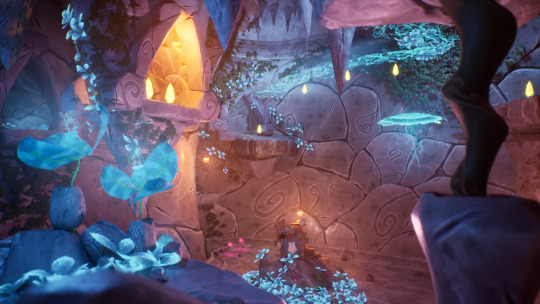
8. Has anyone at Ubisoft or within the gaming industry approached you during your time sharing your development blogs on YouTube?
"No, no one has."
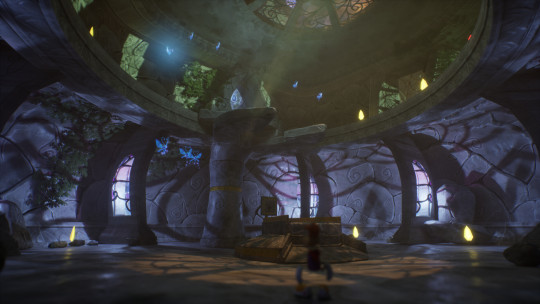
9. Are you planning to do any other Rayman games or any other videogames in Unreal Engine in the future after you have finished with Rayman 3?
"After the Rayman 3 remake, I will start making my own title. I already have a pretty clear idea of what that game is going to be; however, I’m not going to share that information yet. There is a lot of work left in this project, even just for the first level, so I’m still keeping my focus on the remake."

10. You are also a fan of the Unity Engine; can you tell us why?
"I just really enjoy working in it. It’s really cool that anyone can just download this software and start creating a game. I really like how the software is structured. I feel like it's really daunting at first, but once you get the hang of it, using it just makes sense. Nowadays, I don’t really need to revisit many tutorials on how to do some things because I find the whole user experience pretty neatly organized and logical. What’s also really cool is that a lot of features are pretty cutting edge and yet still free to use (this is a bit of a double-edged sword, however, as new features are often pretty risky to use as they are not yet properly tested for production)."
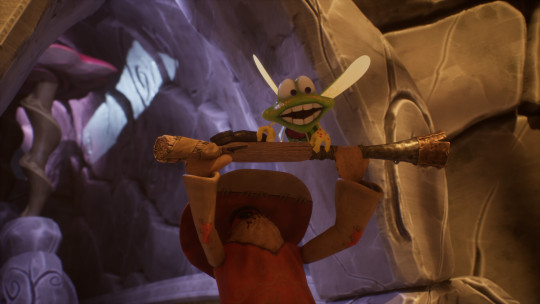
11. How did you get into the Rayman series?
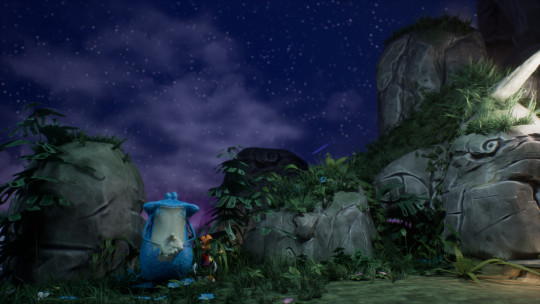
"My first Rayman game was Rayman 1 on the PS1. I was probably around 4 years old or something like that, so I think that it goes without saying that I didn’t beat it back then (and still haven’t, but I never really went back to try). Then, if I’m remembering correctly, I found Rayman 2 lying in a supermarket on a heap with other games and managed to convince my mom to buy it. I was probably around 6. This one I did manage to beat, but it took a long time. Some parts were really challenging back then. Also, it was really hard for me to figure out that I needed to backtrack in order to help Clark. Then I think I got Rayman 3 around the time it came out, so I was probably like around 8. So old enough to beat this one without too many issues. This is also the one that I liked the most at the time. I vividly remember how the first time I booted Rayman 3, I had this weird bug where the left key didn’t work, and I thought that maybe this was intended. I figured that since Rayman doesn’t have his hands (because Globox runs off with them), he has problems with keeping his balance, and that explains why I can't run left. Let me tell you, trying to catch that barrel without the ability to run left was pretty impossible, haha. Luckily, rebooting the game fixed the issue."

12. What is your favorite Rayman game and character?

"My favorite game is either Rayman 2 or Rayman 3, depending on my mood. Both to me have their respective strengths and weaknesses, but both are absolutely amazing. Rayman 2 is unmatched in its atmosphere and level design. Rayman 3 has really fun combat encounters, and I like the characters (design and writing) much more. And the whole Knaaren desert level is just so awesome! When I was a kid, my favorite character was straight up Rayman, but now it’s definitely the teensies. Though Globox from Rayman 3 is a close second place. Whenever I play Rayman Legends, I usually play as a teensie (but if I don’t feel like playing as a teensie, I always go for Rayomz)"

Thank you so much for being a part of my community spotlight, Marked As Unreal. It was a pleasure to read and see some of the creative processes behind the Rayman 3: Fan Remake. I look forward to seeing everything once it's complete. I wish you all the best with the development and in your future projects.
Please don't forget to support Marked As Unreal. If you are eager to see more, I have included links to their social accounts below. Have a good weekend, Rayman fans. See you next time.
MarkedAsUnreal Links:

https://www.linkedin.com/in/marek-holubowski/
Rayman The Boardgame:
Rayman fans, don't forget Rayman: The Boardgame Kickstarter campaign ends on October 8th. There isn't much time until the end of the campaign. If you haven't already, don't forget to pledge and don't miss out on this amazing board game and some amazing bonuses.
52 notes
·
View notes
Text


"He is back and he is seeking revenge!!" That’s what one of my teammates said after we wrapped up a big performance upgrade on a server that was… let’s say, not performing its best. Highs and lows, right? Complex, data-heavy, fast, reliable, and done for the best 'top dogs' in the game (me included).
And then another kind of thing... I was talking with a friend who’s been struggling to find a job in his field (he's studying management, which is a solid and common path). So, why not help a little bit? (That is what is in the image, do not call me a click baiter*)
I strongly believe that if you're struggling to get into any area, a nice way to present yourself is by having a page—it can be pure HTML/CSS or a cloned repo with some kind of "personal website template" using all the NodeJS you want.
Then, turn it into a DNS like "yourname-myprofession.com" so you can show a clean, well-designed QR Code with your avatar during interviews. It’s a cleanest way possible to present your résumé and experience. Tech skills are like magic, especially for those who haven't seen it before.
#study aesthetic#study blog#coding#programmer#programming#software development#developer#software#student#study space#study art#study motivation#study#studyblr#studyblr europe#studyblr community#study inspiration#studying#studyspo#linux#linuxposting#arch linux#open source#computers#github#softwareengineering#software engineer#software engineering#information technology#study life
21 notes
·
View notes
Text






One of the most defining 16bit computers was introduced in June 1985.
ATARI ST 520
DESIGN HISTORY & STRATEGY
The Atari ST series was born in a turbulent time: Atari had just been acquired by Jack Tramiel, founder of Commodore, after leaving that company. Tramiel pushed for a quick-to-market product to compete with the Apple Macintosh and Commodore Amiga.
Development time: Less than one year — an aggressive schedule for a 16-bit GUI-based machine.
Initial models: The Atari 520ST was the first to ship, showcased at CES in 1985.
Innovative design: All-in-one casing (mainboard + keyboard), like the Amiga 500, but with better modularity (external floppy drive, monitor, etc.).
Former C=64 developer Shiraz Shivji led the design team. He tells a story about the Atari ST/Commodore Amiga history (source) "It is very interesting that the Warner Atari difficulties were due to Tramiel’s Commodore. The Commodore 64 was much more successful (I would say wildly successful) compared to the Atari Computers such as the 800 and the 400. We were also taking away sales from the video games division, the Atari 2600. Jay Miner was at Atari in the old days and was involved in the design of their products. He left Atari to design the Amiga. Atari had funded some of this effort and had an option to buy the Amiga. When we took over Atari in July 1984, the first order of business was to decide what to do with this option. The problem was that the Amiga was not quite ready and would need a lot of money to acquire. We decided to pass on Amiga, but this put enormous pressure on our own development team. Commodore, on the other hand, did not have an internally developed 32-bit graphics-oriented machine and did not have the confidence to develop the machine internally. They ended up buying Amiga for between $25-$30 million and spent a further $20 million or so and yet came out with a product a little after Atari. The roles were reversed, the Atari ST has a Commodore pedigree, while the Amiga has an Atari pedigree!"
MIDI AND MUSIC PRODUCTION
The 520ST included built-in MIDI ports — a revolutionary move. At the time, most other computers needed expensive third-party MIDI interfaces.
Key Software:
Steinberg Cubase – became the industry standard for MIDI sequencing.
Notator – early version of what later evolved into Logic Pro.
Pro 24, Dr. T's, and Hollis Trackman – widely used for composing, sequencing, and syncing synthesizers.
Used by Artists:
Fatboy Slim composed with the ST well into the 2000s.
Jean-Michel Jarre, Vangelis, The Chemical Brothers, and Underworld used it in studio setups.
Many studios kept an Atari ST just for MIDI due to its tight timing and reliability.
SOFTWARE ECOSYSTEM
TOS/GEM: A fast and responsive GUI OS that was very usable on 512KB of RAM.
Productivity apps:
Calamus DTP – high-quality desktop publishing
NeoDesk – an improved desktop GUI
GFA Basic – a powerful programming environment
Graphics tools:
Degas Elite, NeoChrome – pixel art, animation
Spectrum 512 – used clever tricks to display 512 colors
While the Amiga had better graphics and sound, many games were first developed for the ST, then ported to Amiga. Key games:
Dungeon Master – first-person RPG with real-time mechanics
Carrier Command, Starglider, Blood Money, Rick Dangerous
Flight simulators, strategy, and adventure games flourished
CULTURAL IMPACT
In Europe (especially the UK, Germany, France, and Hungary):
The ST became a cornerstone of bedroom coding, Demoscene, and music production.
Local software houses and users created a vibrant community around the machine.
The Atari ST was used in schools, small studios, and households well into the early '90s.
In education: The ST's affordability and easy-to-use software made it a favorite in European schools and computer labs.
DECLINE & LEGACY
By the early 1990s, the ST line was losing ground to IBM-compatible PCs and faster Amigas.
Later models like the STE, TT030, and Falcon 030 tried to revitalize the line, with limited success.
Atari shifted toward consoles (like the Jaguar) and left the computer market.
Long-term legacy:
The Atari ST's MIDI legacy lives on — it helped standardize digital music production workflows.
Many musicians and retrocomputing fans still collect and use STs today.
A vibrant retro software/demo scene remains active, especially in Europe.
#atari#atari st#anniversary#tech#technology#old tech#retrocomputing#retro computing#retro gaming#retrogaming#midi#cubase#calamus#notator#degas elite#16bit#Dungeon Master#Carrier Command#Starglider#Blood Money#Rick Dangerous#Flight simulators#80s#80s computer#fatboy slim#chemical brothers#jean michel jarre#vangelis
11 notes
·
View notes
Text
Women's history just got richer
By Mindy Weisberger, CNN
More than 1,000 years ago, carvers in what is now Denmark set their chisels to rock to etch runestones — monuments to Viking leaders naming their deeds and achievements. Two groups of runestones mention a woman named Thyra, and new analysis of the carvings suggests that the runes on both sets of stones were inscribed by the same artisan and refer to the same woman: a Viking queen of considerable power.
Researchers from Denmark and Sweden used 3D scans to analyze carvings on the runestones, finding telltale clues that marked the individual style of the person who carved them. That carver’s repeated mention of Thyra’s name — a rare occurrence for Viking-era women — suggested that Thyra was a powerful sovereign who likely played a pivotal role in the birth of the Danish realm, the scientists reported Wednesday in the journal Antiquity.
“To learn more about the rune-carver and those named on the stone is fascinating,” said Dr. Katherine Cross, a lecturer at York St. John University in the UK who researches and teaches the history of early medieval northern Europe. She was not involved in the study.
“We can only understand early medieval sources once we can think about who made them and why,” Cross told CNN in an email.
One set of runes came from a pair of monuments known as the Jelling stones, erected in the town of Jelling around 965. The larger Jelling stone is often referred to as “Denmark’s birth certificate,” as it’s the first monument to name the land as its people pivoted to Christianity, according to the National Museum of Denmark in Copenhagen.
Both Jelling runestones also named a royal figure: Queen Thyra, mother of then-reigning King Harald Bluetooth. The smaller stone was raised in her honor by her husband (and Harald’s father) King Gorm, calling her “Denmark’s strength/salvation” (or “Denmark’s adornment,” depending on the translation, the researchers noted in the study). Harald commissioned the larger stone, to honor both of his royal parents.

In another set of four Viking-era monuments, known collectively as the Bække-Læborg group, two runestones mention a woman named Thyra. Those stones are associated with a carver named Ravnunge-Tue, but experts disagreed on whether that Thyra was Harald’s mother, said lead study author Dr. Lisbeth Imer, a curator and senior researcher at the National Museum of Denmark specializing in the study of runes and ancient inscriptions.
Before the new investigation, it was unknown who had carved the Jelling stones. Confirming that their carver was Ravnunge-Tue would strengthen the connection between the Jelling and Bække-Læborg runestones, Imer told CNN in an email.
“Then it is much more reasonable to suggest that it was in fact the same Thyra,” she said.
A question of style
Some details in ancient runestones that indicate a carver’s individual style are visible to a trained expert’s eye, such as the language or the basic shape of the runes. Other details are harder to detect, Imer said.
“What you cannot see with the naked eye is the carving technique,” she said.
To get a closer look at the carvings, the researchers took scans of the stones and created 3D digital models, then measured the runes’ grooves with a software tool that weighed variables such as angle, depth and cutting rhythm. Together, these variables can create a unique profile for a carver.
“Every rune carver develops his own motor skill and holds the tools in a certain angle, strikes with a certain strength,” Imer said. “The motor skill is individual and other individuals cannot copy that.”
When the researchers compared runes from Jelling 2 (the larger of the two Jelling stones) and the Læborg stone from the Bække-Læborg group, they found striking similarities, such as height of the runes, straightness of the main staves and length and placement of rune branches.
“In the Læborg and Jelling inscriptions you can follow the cutting rhythm of Ravnunge-Tue as one deep stroke of the chisel followed by two not so deep ones: DAK, dak-dak, DAK, dak-dak,” Imer said via email. “It is ALMOST like hearing the heartbeat of a person that lived so long ago.”
Jelling 1 was more eroded, so its markings were harder to analyze. But if the Læborg runestone was Ravnunge-Tue’s handiwork, Jelling 2 was likely his as well, Imer said. It would mean that the Queen Thyra mentioned twice in the Bække-Læborg group — on Læborg and on the stone Bække 1 — was the same person commemorated on the Jelling stones, the study authors concluded.
In recent years, archaeologists have revised prior interpretations of Viking warrior burials as exclusively male, finding that Viking women were fighters, too. The new findings add to the picture of influential Viking women holding prominent roles in statecraft as well as on the battlefield.
“This research highlights how Viking-Age women wielded power through political authority and patronage, not just violence,” Cross said.
What’s more, the fact that Thyra is mentioned on four runestones offers strong evidence of her importance, Imer added. Fewer than 10 runestones in Denmark from the pre-Christian era mention women at all — and four of those are of Queen Thyra.
“Runestones in Denmark were mostly erected in honour of men, but Thyra is commemorated on more runestones than any other person in Viking Age Denmark,” Imer said. “She must have held extreme power and social position.”
Mindy Weisberger is a science writer and media producer whose work has appeared in Live Science, Scientific American and How It Works magazine.
#Denmark#women in history#Queen Thyra#Viking Queen#Jelling Stones#King Harald Bluetooth#King Gorm#Bække-Læborg group#a carver named Ravnunge-Tue
206 notes
·
View notes
Text
Dreamsoft4u at GITEX Europe 2025 | Showcasing Innovation, Tech Trends & Future Solutions
Join Dreamsoft4u at GITEX Europe 2025 — where innovation meets opportunity! 🌍✨ Explore how Dreamsoft4u is leading the charge in custom software development, healthcare IT solutions, telemedicine innovations, and cutting-edge technologies. 🔵 Discover Dreamsoft4u's latest projects and tech breakthroughs 🔵 Witness industry-defining solutions in action 🔵 Connect with global tech leaders and innovators
Stay future-ready with Dreamsoft4u at GITEX Europe 2025!
View Source: https://www.youtube.com/watch?v=DxhHIX7q3nc
#custom software development#gitex#europe#germany#mobile app development#healthcare software solutions#mobile app development services
0 notes